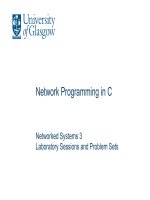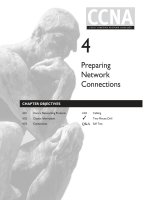Lecture 9: Network programming ppt
Bạn đang xem bản rút gọn của tài liệu. Xem và tải ngay bản đầy đủ của tài liệu tại đây (119.22 KB, 15 trang )
1
Lecture 9:
Network programming
2
Manipulating URLs
URL is an acronym for Uniform Resource Locator and is a
reference (an address) to a resource on the Internet.
Sample structure of a URL. The resource name part may
contain: host name, file name, port number(optional)
and reference (optional)
you can create a URL object in Java from an absolute
URL or a relative URL.
The URL class provides several methods implemented on
URL objects. You can get the protocol, host name, port
number, and filename from a URL.
Protocol Identifier
Resource Name
3
Example code
import java.net.*;
import java.io.*;
public class ParseURL {
public static void main(String[] args) throws Exception {
URL aURL = new URL(":80/docs/books/" +
"tutorial/index.html#DOWNLOADING");
System.out.println("protocol = " +
aURL.getProtocol()); System.out.println("host = " +
aURL.getHost()); System.out.println("filename = " +
aURL.getFile()); System.out.println("port = " +
aURL.getPort()); System.out.println("ref = " +
aURL.getRef());
}
}
Output of the above code:
protocol = http
host = java.sun.com
filename = /docs/books/tutorial/index.html
port = 80
ref = DOWNLOADING
4
Connecting with a URL (1)
openStream(): returns a java.io.InputStream
object, from which you can read easily as reading
from an input stream. It may throw an IOException
Example code
import java.net.*;
import java.io.*;
public class ReadURL {
public static void main(String[] args) throws Exception {
URL osu = new URL(" />BufferedReader in = new BufferedReader(
new InputStreamReader(osu.openStream()));
String inputLine;
while ((inputLine = in.readLine()) != null)
System.out.println(inputLine);
in.close();
}
}
This prints out the source code for the webpage
www.itu.edu
5
Connecting with a URL (2)
openConnection(): Returns a URLConnection object
that represents a connection to the remote object
referred to by the URL. It may throws an
IOException
try {
URL osu = new URL(" /> URLConnection osuConnection = osu.openConnection();
} catch (MalformedURLException e) { // new URL() failed
. . .
} catch (IOException e) {
. . .
}
The URLConnection class provides many methods to
communicate with the URL, such as reading and
writing.
6
Sockets
Sometimes you need a low-level network
communication, such as a client-server
application
The TCP protocol provides a reliable point-to-
point communication channel via the sockets.
A socket is an endpoint for reliable
communication between two machines. To connect
with each other, each of the client and the
server binds a socket to its end for reading and
writing.
The java.net package provides two classes —
Socket and ServerSocket — to implement the client
and the server, respectively.
7
Establishing a simple server
Five steps:
1). Create a ServerSocket object
ServerSocket server=new
ServerSocket(port,queueLength);
2). The server listens indefinitely (or blocks) for an
attempt by a client to connect
Socket connection = server.accept();
3). Get the OutputStream and InputStream objects that
enable the server to communicate with the client
by sending and receiving bytes
InputStream input = connection.getInputStream();
OutputStream output = connection.getOutputStream();
* You can get a stream of other data types from the InputStream
and OutputStream
4). Processing phase: the server and the client
communicate via the InputStream and the OutputStream
objects
5). After the communication completes, the server closes
the connection by invoking close() on the
Socket and the corresponding streams
8
Establishing a simple client
Four steps:
1). Create a Socket object
Socket connection = new Socket (serverAddress, port);
2). Get the OutputStream and InputStream of the
Socket. The server and the client must send and
receive the data in the same format
3). Processing phase: the server and the client
communicate via the InputStream and the
OutputStream objects
4). After the communication completes, the client
closes the connection.
9
The server side
import java.lang.*;
import java.io.*;
import java.net.*;
class Server {
public static void main(String args[]) {
String data = "Let's test if we can connect ";
try {
ServerSocket server_socket = new ServerSocket(1234);
System.out.println("I’ve started, dear clients ");
Socket socket = server_socket.accept();
System.out.print("Server has connected!\n");
PrintWriter outToClient = new
PrintWriter(socket.getOutputStream(), true);
System.out.print("Sending string: ‘" + data + “’\n");
outToClient.print(data);
outToClient.close();
socket.close();
server_socket.close();
}
catch(Exception e) {
System.out.print("Whoops! It didn't work!\n");
}
}
}
A simple server/client pair example
10
A simple server/client pair example (cont.)
The client side
import java.lang.*;
import java.io.*;
import java.net.*;
class Client {
public static void main(String args[]) {
try {
Socket socket = new Socket("localhost", 1234);
BufferedReader inFromServer = new BufferedReader(new
InputStreamReader(socket.getInputStream()));
System.out.print("Received string: ‘");
while (inFromServer.ready())
System.out.println(in.readLine()); //Read one line and output it
inFromServer.close();
}
catch(Exception e) {
System.out.print("Whoops! It didn't work!\n");
}
}
}
11
A simple server/client pair example (cont.)
What happens on the screen if you run the code?
First run Server.java
Then run Client.java
12
A simple server/client pair example (cont.)
If you run Client.java without running
Server.java
13
Datagrams
The UDP protocol provides a mode of network
communication whereby datagrams are sent over the
network. DatagramSockets are used for the
connection.
A datagram’s arrival, arrival time and order of
arrival is not guaranteed. It’s used whenever an
information needs to be broadcast periodically
14
UDP example
import java.net.*;
class GetDate {
final static int PORT_DAYTIME = 13;
public static void main(String[] args) throws Exception {
DatagramSocket dgsocket = new DatagramSocket();
InetAddress destination =
InetAddress.getByName("news.cis.ohio-state.edu");;
DatagramPacket datagram;
byte[] msg = new byte[256];
datagram = new DatagramPacket(msg, msg.length, destination,
PORT_DAYTIME);
dgsocket.send(datagram);
datagram = new DatagramPacket(msg, msg.length);
dgsocket.receive(datagram);
String received = new String(datagram.getData());
System.out.println("Time of machine:" + received);
dgsocket.close();
}
}
Sample excution:
alpha> java GetDate
Time of machine: Tue May 24 00:16:42 2005
15
Supplemental reading
Custom networking
/>.html
JavaTM Programming Language Basics, Socket
Communications
/>rogramming/BasicJava2/socket.html









